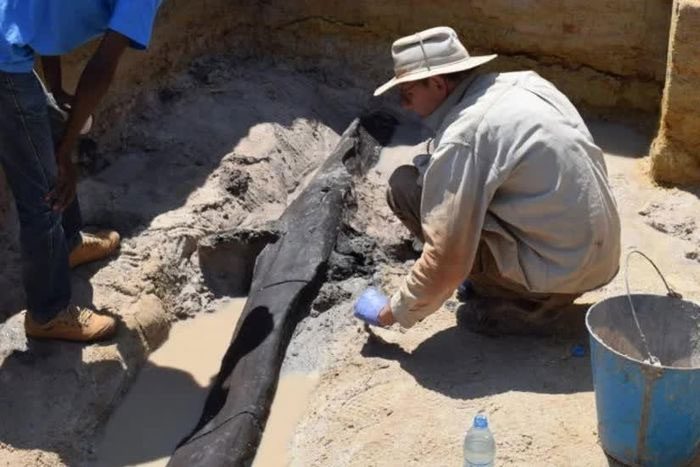According to a publication in the scientific journal Nature on September 20, archaeologists have unearthed a wooden structure believed to be the oldest ever discovered, dating back nearly half a million years, showcasing the advanced capabilities of ancient humans.
As reported by AFP, this exceptionally well-preserved wooden structure was found by scientists at Kalambo Falls in northern Zambia, near the border with Tanzania. Through the markings on the wooden structure, scientists concluded that stone tools were likely used to join two large logs, resulting in the formation of this structure. Its purpose may have been as a platform or a walkway elevated above the water level.

The wooden structure is approximately 476,000 years old. (Photo: Geoff Duller/Aberystwyth University/Reuters).
Mr. Larry Barham, an archaeologist at the University of Liverpool in the UK and the lead author of the study, stated that the discovery of this structure was completely a “serendipitous discovery” made in 2019 during excavations at a site along the banks of the Kalambo River, above the 235-meter-high waterfall.
Wooden artifacts are relatively rare due to the tendency of wood to decay over time, leaving few traces in history. However, with this structure, scientists believe that the high water levels at Kalambo Falls have aided in its preservation over the centuries.
Instead of using radiocarbon dating, scientists employed a new method known as optically stimulated luminescence dating. Specifically, the age of the wood was determined by measuring the natural radioactivity in the minerals within the fine sediment layers surrounding the wood to ascertain the last time it was exposed to sunlight.
The results confirm that this wooden structure is at least 476,000 years old, far older than researchers expected, especially considering that the previously oldest known wooden structure was about 9,000 years old. This also means that it predates the evolution of modern humans, Homo sapiens, by around 300,000 years.
This discovery has led many scientists to revise their perspectives, as around this time, ancestors of modern humans were known to use wood but only for limited purposes such as making fires or hunting. According to AFP quoting Mr. Barham, ancient people “transformed their environment to make life easier, even if it was just by creating a platform to sit by the river for daily tasks.”
He remarked: “They utilized their intelligence, imagination, and skills to create something they had never seen before, something that had never existed before,” reflecting a level of abstract thinking and “possibly language.”

Part of the wooden structure found. (Photo: Larry Barham/University of Liverpool).

Scientists excavating the wooden structure at Kalambo Falls, Zambia. (Photo: Geoff Duller/Aberystwyth University)
Additionally, the authors of the study noted that this discovery challenges the view that human ancestors were nomadic. This is because the wooden structure appears to be a long-term dwelling near a waterfall, a longstanding water source. However, some opinions warn that this hypothesis has yet to be proven, as the structure could have been seasonally installed rather than permanent.


















































